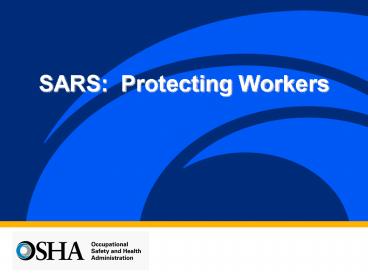Alliances - PowerPoint PPT Presentation
1 / 18
Title: Alliances
1
SARS Protecting Workers
2
OSHA Guidance for Employers on Severe Acute
Respiratory Syndrome (SARS)
- Potentially deadly respiratory disease
- Coronavirus is the leading suspected causative
agent - Most U.S. cases contracted by those who have
traveled to Asia, more recently also Toronto - Spread primarily by close person-to-person
contact - In the U.S., healthcare workers face greatest
risk of workplace transmission
3
SARS Possible Symptoms
- Fever
- Chills
- Muscle aches
- Dry cough
- Shortness of breath or difficulty
breathing
4
Suspect Cases of SARS
- Onset within 10 days foreign travel or close
contact with someone with SARS - Fever of at least 100.4 degrees F
- Respiratory illnesscough, shortness of breath,
difficulty breathing
5
SARS Potential High Risk Population
- Age 40 or older especially those over 65
- Have other medical conditions (heart/liver
disease) - Hospital worker or family member of victim
6
SARS Transmission
- Spread through airborne droplets released when
infected person coughs or sneezes - Or through contact with body fluids
- Not likely to be transmitted in offices or on
public transportation
7
SARS Treatment
- Treatment options may be influenced by severity
of the illness - The majority of those affected by SARS get better
in a week - Some may get worse, may need mechanical
ventilators to breathe - Death rate appears to be higher for patients over
60
8
SARS Precautions for Workplaces
- Centers for Disease Control documents
- provide most up-to-date information at
- www.cdc.gov/ncidod/sars
- See also the World Health Organization
- SARS webpage at
- www.who.int/csr/sars/en/
9
SARS OSHA Recommendations
- See OSHA suggested practices at
www.osha.gov/dep/sars/index.html - Or click on S in the OSHA homepage index
10
Precautions for Healthcare Facilities
- Universal or standard precautions, including
frequent handwashing - PPE gowns, gloves, N95 respirators, eye
protection - Airborne precautions, including isolation rooms
with negative pressure for suspected SARS cases - Low or Intermediate level disinfectants
11
Precautions for Laboratories
- PPE disposable gloves, gowns, eye protection
and respiratory protectionN95, N100, or PAPR
with HEPA filters - Manipulation/testing of specimenscertified
biological safety cabinet - Low or intermediate level disinfectants
12
Precautions for Airline Flight Crews/Airport
Personnel
- All workers should use good hygiene practices,
including frequent hand washing - Respiratory protection has not been recommended
by CDC for airline crews - Airline cleaning crews, INS, TSA workers should
wear gloves where appropriate
13
Precautions for Airplane Cleaning Crews
- Wear disposable gloves
- Do not use compressed air for cleaning
- Discard gloves after cleaning
- Use soap and water to wash hands
after cleaning - If soap and water are not available, use
alcohol-based hand wash - Wipe down frequently touched surfaces in the
passenger cabin with low or intermediate level
disinfectant
14
Precautions for Air Medical Transport of SARS
Patients
- Use respiratory protection (N95)
- Wear appropriate gloves
- Wear protective clothing if there is potential
for exposure to blood or body fluids - Follow standard hygiene practices, including
frequent handwashing
15
Precautions for Handling Human Remains of SARS
Patients
- Use N95 or higher respirators
- Wear surgical scrub suit, surgical cap, gown or
apron, eye protection, shoe covers, double gloves - Use good hygiene practices, frequent handwashing
- Refer to CDC website for more detailed
precautions
16
Employee Training
- All employees with potential exposure should
receive training - Training should cover hazards and protocols at
worksite to reduce exposures and isolate and
report SARS cases - Workers who experience SARS symptoms should be
excluded from duty and referred to a healthcare
provider
17
CDC Suggestions for Family Members Caring for
SARS Patients at Home
- Detailed guidance for family members of SARS
patients available from CDC www.cdc.gov/ncidod/
sars/factsheetcc.htm
18
(No Transcript)































